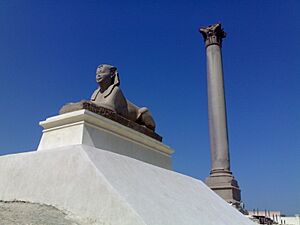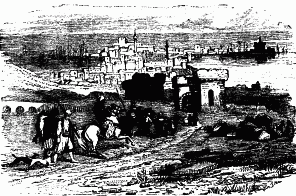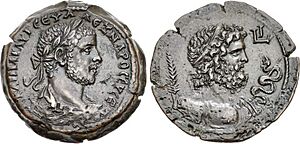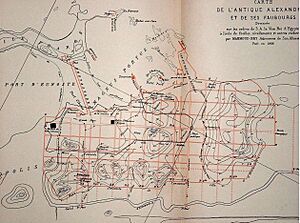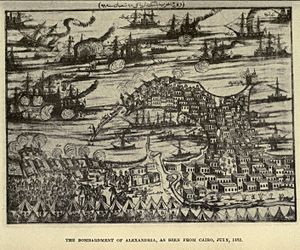History of Alexandria facts for kids
The history of Alexandria is super interesting! This famous city was started by Alexander the Great way back in 331 BC. But even before that, there were big port cities nearby, like Canopus and Heracleion, which were important for shipping on the Nile River.
After Alexander founded it, Alexandria became the main city of the Ptolemaic Kingdom. It quickly grew into one of the biggest and most important cities in the Hellenistic world. Only Rome was larger and richer, especially after Rome took control of Egypt in 30 BC.
The city was taken by the Arabs in AD 641. A new capital for Egypt, Fustat, was built along the Nile. After losing its capital status, Alexandria slowly became less important. By the time of the Ottoman Empire, it was mostly a small fishing village.
In 1798, the French army, led by Napoleon, captured the city. Soon after, the British took it from the French in 1801. The British kept a strong influence over Alexandria for 150 years. The city started to grow again in the early 1800s, thanks to Mohammad Ali's efforts to bring new industries to Egypt.
Today, Alexandria is Egypt's main port. It's a busy center for business, tourism, and transportation. It's also a big industrial area where things like refined petroleum, asphalt, cotton fabrics, and plastics are made.
Contents
Ancient Settlements Near Alexandria
Just east of where Alexandria is now, there used to be marshlands and islands. Long ago, around the 7th century BC, there were important port cities called Canopus and Heracleion. Heracleion was recently found underwater! Part of Canopus is still on land and has been studied by archaeologists for a long time. There was also a town called Menouthis. The Nile Delta area was always important because it was the main way to trade with Egypt by sea.
Before Alexandria was built, an Egyptian town called Rhakotis was located on the coast where Alexandria now stands. According to old stories, there were also five small villages scattered between Lake Mareotis and the sea.
How Alexandria Was Founded
Alexander the Great founded Alexandria in 331 BC. The exact date is still debated by historians. Alexander's main architect for the city was Dinocrates. Many old stories talk about how the city was planned. One story says Alexander used grain to sketch out the city's layout because he didn't have chalk. Other more imaginative stories about its founding can be found in ancient writings.
A few months after starting the city, Alexander left Egypt and never came back. His helper, Cleomenes, continued to build and expand the city.
Later, one of Alexander's generals, Ptolemy (who became Ptolemy I of Egypt), managed to bring Alexander's body to Alexandria. Alexander's tomb became a very popular place for ancient travelers to visit, even Julius Caesar came to see it. Having Alexander's tomb and the famous Lighthouse of Alexandria helped the Ptolemy family show that they had the right to rule.
Alexandria was meant to be the new main Greek center in Egypt, replacing Naucratis. It was also designed to connect Greece with the rich Nile Valley. The location was perfect: it was protected by the Pharos island and away from the mud carried by the Nile River. The city also had a fresh water supply from the Nile through a canal. Plus, it was naturally protected from invading armies by the huge Libyan Desert to the west and the Nile Delta to the east.
Even though Cleomenes was in charge of building, the Heptastadion (a causeway connecting Pharos Island to the mainland) and the main parts of the city were mostly built by the Ptolemies. We don't know exactly how Alexandria grew so quickly to be such a huge city.
The Ptolemaic Era
Alexandria took over the trade that used to go through the city of Tyre. It became the center for new trade between Europe and the lands to the east, like Arabia and India. In less than a generation, Alexandria grew bigger than Carthage. Within a century, it became the largest city in the world. For several centuries after that, it was second only to Rome. It was the main Greek city in Egypt, with a unique mix of Greeks from many different places.
Building Grand Structures
Many impressive buildings were put up in Alexandria during the 3rd century BC. The Heptastadion connected Pharos Island to the city. The Lighthouse of Alexandria was built soon after, as was the Serapeum, all under Ptolemy I. The Museion was built under Ptolemy II. The Serapeum was made even bigger by Ptolemy III Euergetes. And special tombs for Alexander and the Ptolemy rulers were built under Ptolemy IV.
The Great Library of Alexandria
The Ptolemy rulers strongly supported the Library of Alexandria and the Musaeum (a center for learning). These places became famous for Hellenistic studies.
Many brilliant thinkers were part of the Musaeum. These included Euclid, who taught about geometry; Hipparchus, an astronomer; and Eratosthenes, who figured out the Earth's size and created a way to find prime numbers. Eratosthenes even became the head librarian!
The ancient writer Strabo listed Alexandria, along with Tarsus and Athens, as one of the world's most learned cities. He noted that Alexandria welcomed scholars from other places and also sent its own people abroad for more education.
Different Groups of People
The early Ptolemy rulers made sure to keep the three main groups of people in Alexandria separate: Greek, Jewish, and Egyptian. At first, Egyptians were probably the largest group, while the Jewish community was smaller. Greeks in Alexandria really focused on Hellenistic culture. This helped them keep non-Greeks separate and in a lower position.
The laws in Alexandria were based on Greek laws. There were also two places in the city dedicated to keeping Greek culture alive. In literature, non-Greek writings were only added to the library if they were translated into Greek. There were very few mentions of Egypt or native Egyptians in Alexandrian poetry. When Egyptians were mentioned, it was sometimes in a negative way. Big religious parades were held in the streets to show off the Ptolemies' wealth and power. These parades also celebrated Greek identity and helped to show Greek superiority, which made the differences between cultures even bigger.
These divisions led to many problems later on. Alexandria was also home to the largest Jewish community in the ancient world. The Septuagint, a Greek translation of the Hebrew Bible, was created there. Jewish people lived in two of the city's five areas and worshipped in synagogues.
The Roman Era
Alexandria had been under Roman influence for over a hundred years. In 80 BC, it officially became part of the Roman Empire. Julius Caesar spent time with Cleopatra in Alexandria in 47 BC. He was even trapped in the city by Cleopatra's brother. Mark Antony also spent time there. After Antony's defeat, Octavian took Egypt as his own personal property. He appointed a special governor who reported only to him, not to the Roman Senate.
After becoming part of the Roman Empire, Alexandria seemed to become rich again. It was a very important source of grain for Rome. This was a main reason why Octavian wanted to control it directly.
Tensions between Jewish and Greek people in the Roman period led to riots in AD 38 and again in 66. Buildings were burned during a war in AD 115. This gave Emperor Hadrian a chance to rebuild parts of the city.
In AD 215, the emperor Caracalla visited Alexandria. Because the people had made fun of him, he ordered his soldiers to kill many young men. This terrible order led to a general massacre.
In the 3rd century AD, Alexander's tomb was closed to the public. Its exact location has been lost over time.
Late Roman and Byzantine Times
Alexandria became very important as a center for Christian teachings and church leadership. It was here that Arianism became well-known, and where Athanasius fought against Arianism and against people who still followed old pagan religions. He was successful against both, and the Patriarch of Alexandria (the head of the church in Alexandria) had a lot of influence on Christianity for the next two centuries.
The persecution of Christians under Diocletian (starting in AD 284) marks the beginning of the Era of Martyrs in the Coptic calendar.
As Egyptian influences grew stronger in the Nile valley, Alexandria slowly became less connected to Egypt. It lost much of its trade as the Roman Empire became less stable in the 3rd century. The city's population and beauty quickly declined.
In 365, a huge wave (tsunami) caused by an earthquake in Crete hit Alexandria.
In the late 4th century, Christians began to persecute followers of pagan religions more intensely. Temples and statues were destroyed across the Roman Empire. Pagan rituals were forbidden, and libraries were closed. In 391, Emperor Theodosius I ordered all pagan temples to be destroyed. The Patriarch Theophilus carried out this order. The Serapeum of the Great Library was destroyed, which might have led to the final destruction of the Library of Alexandria. The philosopher Hypatia, who followed a pagan philosophy, was publicly killed by a Christian mob.
By the 5th century, the Brucheum and Jewish areas of the city were empty. Important central monuments, like the Soma and Museum, fell into ruins. On the mainland, life seemed to center around the Serapeum and Caesareum, both of which became Christian churches. However, the Pharos and Heptastadium areas remained busy and untouched.
Recent archaeological digs at Kom El Deka have found the Roman part of Alexandria under layers of graves from the Muslim era. The remains found there, from around the 4th to 7th centuries AD, include workshops, shops, houses, a theater, a public bath, and lecture halls, as well as Coptic paintings. The baths and theater were built in the 4th century, and smaller buildings were constructed around them. This suggests that the city was being rebuilt after the time of Diocletian.
Arab Rule
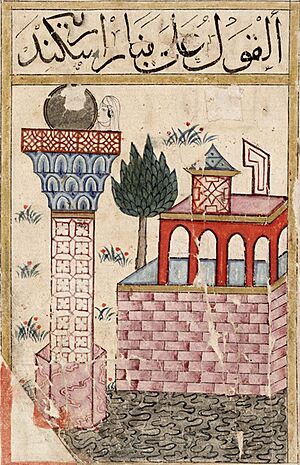
In 619, the city was taken by Khosrau II, the King of Persia. Even though the Byzantine Emperor Heraclius got it back a few years later, the Arabs, led by general Amr ibn al-As, captured it for good in 641. This happened after a siege that lasted 14 months. The city didn't get help from Constantinople during this time. This ended 975 years of Greek and Roman control over Alexandria.
Almost two centuries later, between 814 and 827, Alexandria was controlled by pirates from Andalusia (modern-day Spain). It then returned to Arab control. In 828, the body of Mark the Evangelist was supposedly stolen by merchants from Venice, which led to the building of the Basilica of Saint Mark. Years later, the city suffered many earthquakes in 956, 1303, and 1323.
After a long period of decline, Alexandria became a major city again during the time of the Crusades. It had a thriving period because of trade agreements with Italian cities like Aragon, Genoa, and Venice. These cities distributed goods that came from the East through the Red Sea. Alexandria was part of the Ayyubid Empire. In 1365, Alexandria was brutally attacked and taken by the armies of the Crusaders, led by King Peter of Cyprus.
In the 14th and 15th centuries, Venice lost its trading power in Alexandria. The city's importance for trade declined even more when the Portuguese found a sea route around Africa in 1498. This decline got worse with the Turkish invasion.
There's a common belief that the Library of Alexandria and its books were destroyed in 642 during the Arab invasion.
The Lighthouse was destroyed by earthquakes in the 14th century. By 1700, Alexandria was just a small town among ruins.
Even though it was smaller, the city remained an important port for Mediterranean trade throughout the medieval period under the Mamluk sultanate. It played a role in the trade network of Italian city-states. However, it declined even more under the Ottoman Empire. It lost its water supply from the Nile, and its importance for trade decreased as Rosetta became a more useful port.
Modern History
Napoleon's Invasion
Alexandria was a very important place in Napoleon's military expedition to Egypt in 1798. French troops stormed the city on July 2, 1798. It stayed in their hands until the British won the Battle of Alexandria on March 21, 1801. After this, the British surrounded the city, and it fell to them on September 2, 1801.
In 1798, two French experts estimated Alexandria's population to be between 8,000 and 15,000 people.
Muhammad Ali's Influence
Muhammad Ali, who was the Ottoman Governor of Egypt, started rebuilding the city around 1810. By 1850, Alexandria had returned to something like its former glory.
British Occupation
In July 1882, the city was the site of the first battle of the Anglo-Egyptian War. The Royal Navy bombarded and occupied the city. Large parts of Alexandria were damaged in the battle or destroyed by fires that followed.
Republic of Egypt
Relations between Egypt and the United Kingdom became tense in the 1950s. Violence sometimes broke out between local police and the British Army in Alexandria and Cairo. These clashes led to the Egyptian coup of 1952. During this event, the army took control of Alexandria and forced King Farouk out of his home at Montaza Palace.
In July 1954, the city was targeted by an Israeli bombing campaign, which later became known as the Lavon Affair. A few months later, Alexandria's Manshia Square was the location of a famous, but failed, attempt to assassinate Gamal Abdel Nasser.
Recent Discoveries
In July 2018, archaeologists found a 2,000-year-old, 30-ton black granite sarcophagus. Inside, there were three damaged skeletons in reddish-brown water. According to archaeologist Mostafa Waziri, the skeletons looked like a family burial: a middle-aged woman and two men. Researchers also found a small gold object and three thin sheets of gold.
In June 2022, archaeologists announced the discovery of an alabaster bust (a statue of the head and shoulders) of Alexander the Great. They also found molds and other materials used to create good luck charms for warriors and statues of Alexander the Great.
See also
- Timeline of Alexandria
Images for kids




